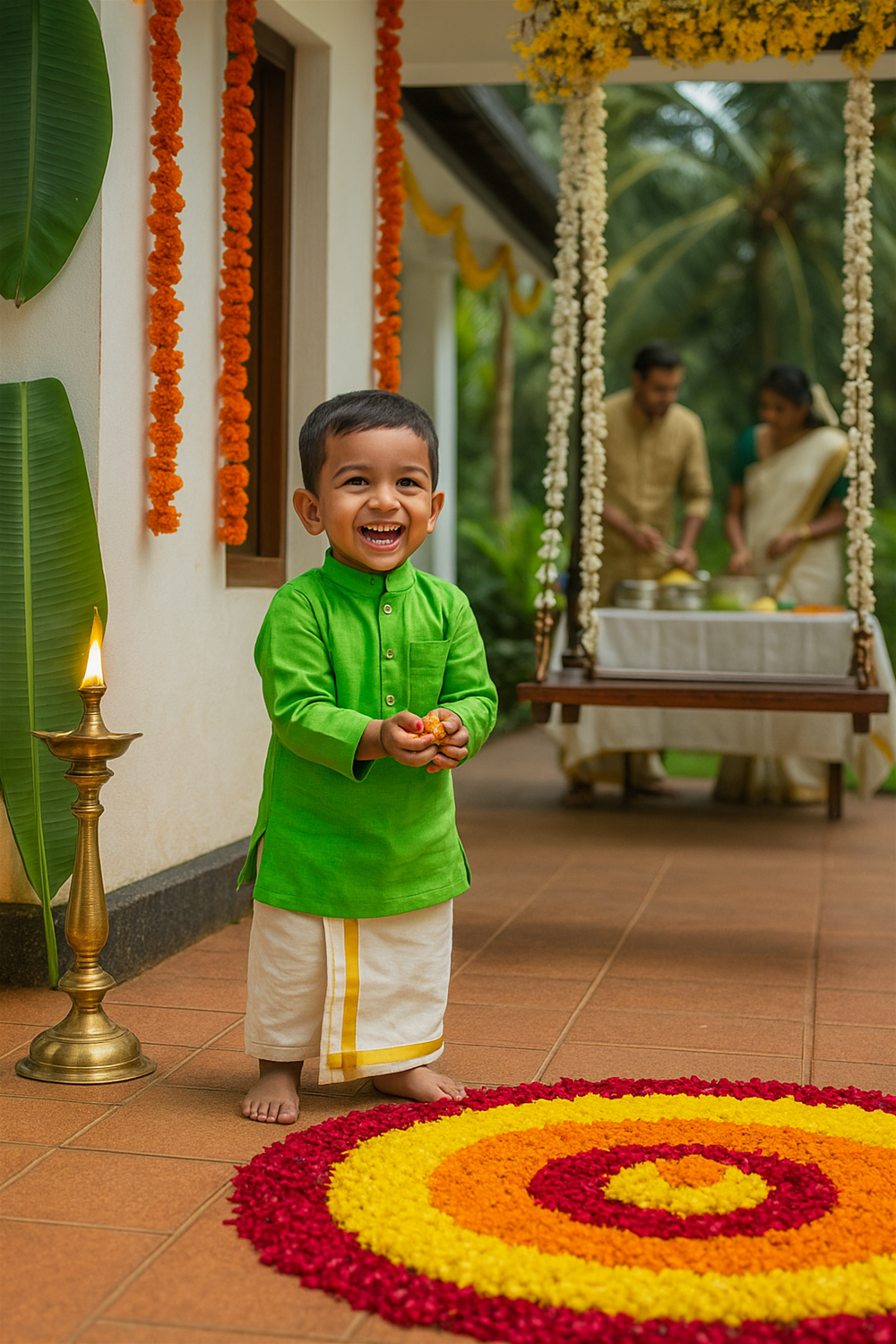
26517 Boys Linen Cotton Bright Green Kurtha in Full Sleeves
Send With EMS Speed Post
Flexible returns
The boy wears a bright green mandarin-collar kurta with a single chest pocket, paired with an off-white dhoti featuring a gold border. Crafted from breathable cotton, the attire blends traditional Kerala styling with child-friendly tailoring. Full sleeves, side slits, and simple detailing ensure comfort. The barefoot look honors cultural customs, while the vibrant color harmony with the floral rangoli captures the joyous and auspicious spirit of Onam celebrations.
Bright Green Kurta – Vibrant Festive Appeal
The upper garment is a kurta in a striking shade of bright green, an intentional choice that symbolizes prosperity, harmony, and renewal. This lively hue not only reflects the festive atmosphere of Onam but also draws attention to the child, making him the visual focal point of the celebration. The color stands out beautifully against the earthy tones of the background and the floral rangoli beneath his feet.
2. Mandarin Collar – Minimalist Elegance
The kurta features a mandarin collar, which is a short, stand-up collar style often found in South Asian and Indo-fusion wear. It provides a clean, sharp neckline without the visual heaviness of a folded collar. This choice adds a modern twist to a traditional garment, balancing comfort and style for a young child while allowing free neck movement.
3. Single Patch Pocket – Practical and Decorative
A single patch pocket is placed on the left side of the chest, subtly blending into the kurta’s design. While functional, the pocket also adds a sense of casual charm. In children’s wear, such details often have dual roles—serving as a practical element for small items (like a flower petal) while enhancing the visual symmetry of the outfit.
4. Button Placket – Classic and Kid-Friendly
The front placket features three buttons, likely made from lightweight plastic or resin, closely matching the kurta’s green tone. The partial placket design is practical for a child—it allows the kurta to be worn and removed without fully unbuttoning, minimizing fuss during dressing while maintaining a neat and structured look.
5. Full Sleeves – Traditional and Modest
The kurta is designed with full-length sleeves, honoring traditional Indian menswear styling. Long sleeves not only enhance the formal tone but also make the outfit suitable for religious or cultural gatherings where modesty is appreciated. The relaxed fit ensures the child’s arms can move freely while playing or participating in rituals.
6. Side Slits – Comfort in Movement
Small slits on either side of the kurta hemline increase ease of movement and prevent fabric from pulling when the child bends, sits, or runs. Side slits are a staple of kurta construction, rooted in both practical tailoring and cultural aesthetics. They keep the silhouette straight while improving ventilation in warm climates like Kerala’s during Onam.
7. Handloom Cotton Fabric – Breathable and Festive
The kurta appears to be made from a lightweight, handloom-woven cotton. This fabric choice is seasonally appropriate for Onam, which occurs during Kerala’s late monsoon when humidity is high. Cotton’s breathability ensures comfort for the child throughout the day, while its natural texture resonates with the festival’s connection to tradition and nature.
8. Off-White Dhoti-Style Bottom – Cultural Heritage
The lower garment is an off-white dhoti-style mundu or veshti, a traditional Kerala men’s attire adapted here for children. This is a straight, ankle-length wrap-around piece, secured at the waist and worn without pleats in the front for ease in kids’ clothing. Its simplicity complements the kurta’s vibrant green without competing for visual attention.
9. Gold Border on Dhoti – Subtle Festive Accent
A single golden zari border runs vertically down the front of the dhoti. This feature is both decorative and culturally symbolic—gold in Kerala attire represents auspiciousness, prosperity, and festivity. The restrained width of the border keeps the outfit light and child-appropriate while still tying it to traditional ceremonial wear.
10. Barefoot Styling – Authentic Cultural Practice
The boy is barefoot, a significant detail in cultural context. In Kerala traditions, being barefoot during religious and festive activities shows respect for sacred spaces and rituals. It also enhances the authenticity of the look, as many families continue this practice during Onam and other celebrations.
11. Fit – Comfort-Oriented yet Structured
The outfit’s tailoring balances structure and comfort—while the kurta has a slightly boxy cut that gives it shape, the dhoti’s draping is loose and airy. This duality ensures the boy looks neat and festive without feeling restricted, a crucial factor for children’s traditional clothing.
12. Accessories – Fresh Flower Garland Accent
A fresh jasmine garland hangs from the swing behind him, adding to the scene’s sensory richness. While not directly part of his attire, the garland visually frames his outfit, enhancing the festive tone. In traditional settings, boys may also wear a small flower tucked behind the ear, though here the flowers are held in a plate for pookalam decoration.
13. Color Harmony with Background
The green kurta contrasts harmoniously with the marigold-yellow, orange, and pink floral rangoli at his feet, creating a balanced yet lively color palette. The off-white dhoti complements the white and gold attire of the adults in the background, subtly tying the entire scene together in a unified visual theme.
14. Age-Appropriate Adaptation of Traditional Wear
While the outfit retains full cultural authenticity, it is clearly tailored for a young child. The dhoti is likely stitched or partially elasticated for easier wearing, avoiding complex wrapping. The kurta’s length is kept slightly shorter than adult versions to prevent tripping or discomfort, ensuring safety and ease during active play.
15. Symbolism of the Outfit in Onam Context
The ensemble as a whole symbolizes Kerala’s rich cultural heritage and the joy of Onam. Green represents fertility, abundance, and renewal; off-white symbolizes purity; and gold stands for prosperity. Together, these colors and garments narrate a story of celebration, tradition, and familial warmth—a living embodiment of the festival’s spirit, passed down to even the youngest members of the family.


